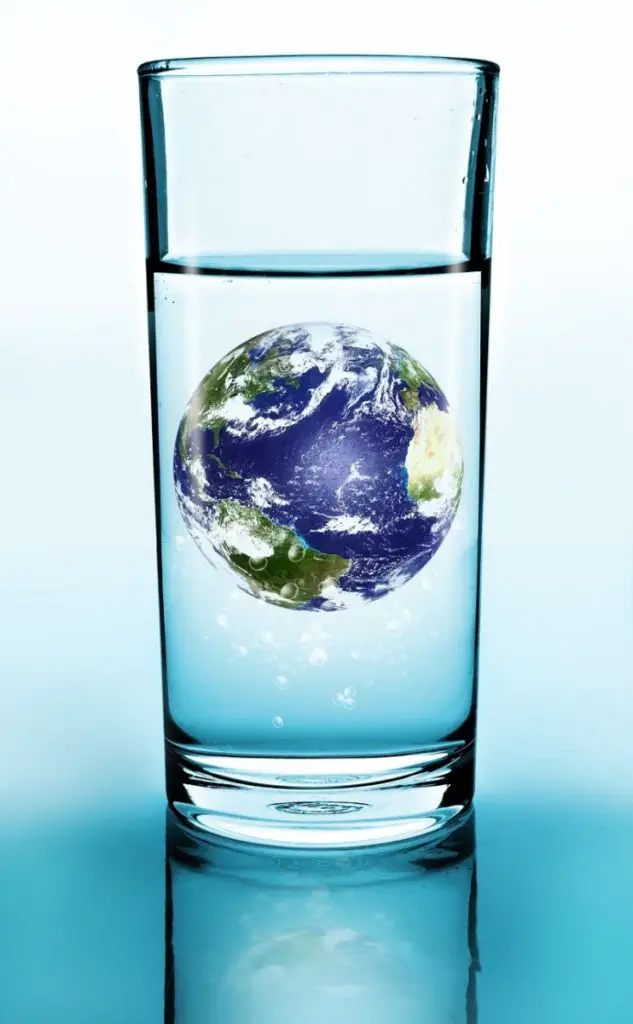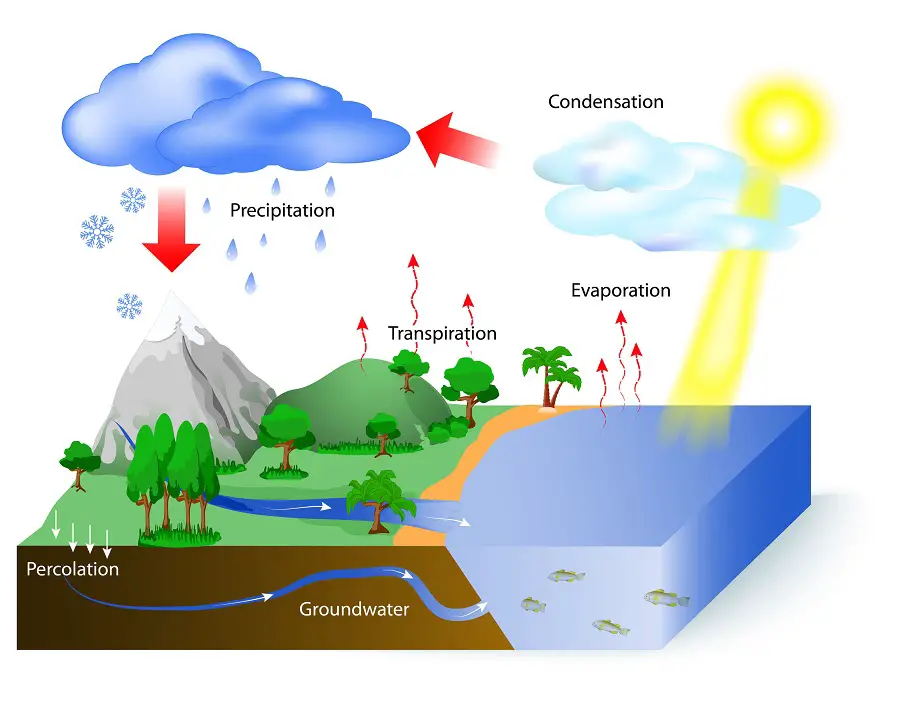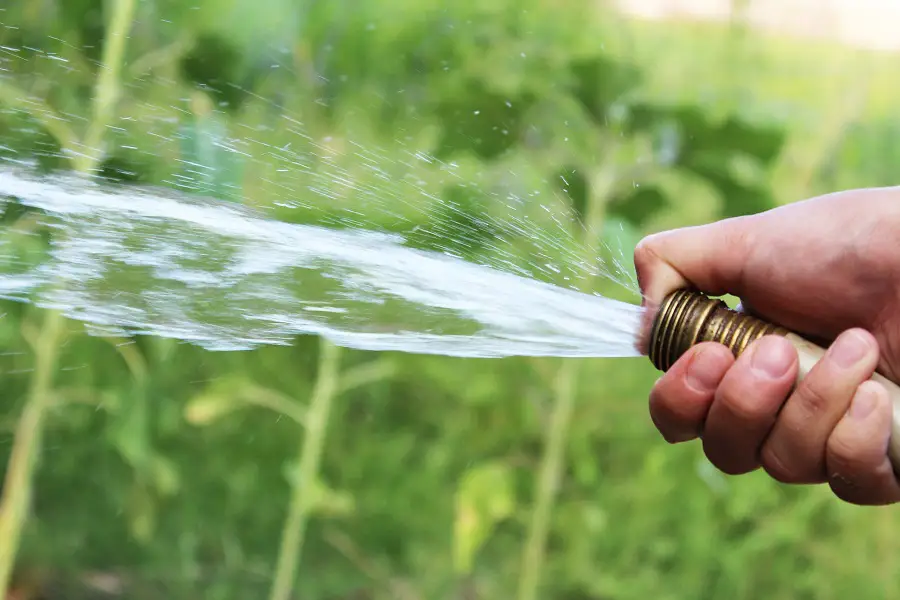The whole purpose of reverse osmosis for drinking water is to remove unwanted dissolved solids from your water. If you remove dissolved solids from water, they have to go somewhere. In reverse osmosis, they are rinsed down the drain. But is this actually waste?
How does reverse osmosis waste water? Reverse osmosis drinking water systems filter out unwanted contaminants from water by forcing the water through a semi-permeable membrane that allows water to pass through it, but filters out dissolved solids from the water. These dissolved solids get rinsed away and discharged to waste.
How does reverse osmosis remove dissolved solids from water?
You may have heard some people talk about how reverse osmosis systems waste a huge amount of water. I think that it is definitely a matter of opinion since the whole purpose of reverse osmosis is to provide you and your family with better quality drinking water.
A reverse osmosis drinking water system does reject water down the drain as it is making your purified water, but it does this to get rid of the extra contaminants in your water that you are trying to get rid of.
If you peel away a banana’s skin to get at the banana inside, you have to get rid of the banana peel right. You eat the banana to get the benefits of the nutrition of the banana and then you throw the banana skin into the garbage. Or even better, you throw the banana skin onto a mulch pile, but either way, the skin is going to waste.
Either way, that banana skin will eventually decay and become nutrients to allow something else to grow and therefore, that banana skin will be introduced back into the food chain.
When you drink water from a reverse osmosis system, you are benefiting from the purified water that is coming from the faucet, and the impurities that have been removed get discharged down the waste drain.

That water going down the drain with the dissolved solids in it that we do not want to drink, will go back into the earth and be re-used for some other purpose.
This is very much like what happens to water as it goes through what is called the water cycle. The cycle of water going through the earth, then evaporated into the atmosphere, collected together to form clouds, and then it falls back down to the earth as rain.

Not sure about how often you should be changing your reverse osmosis filters? Check out my article on “How Often YOU Should Change YOUR Reverse Osmosis Filters“.
Why does reverse osmosis have to waste water anyway?
It boils down to if you want to separate the good water from the bad stuff in the water, the bad things in the water have to go somewhere. So naturally, the bad stuff will go down the drain.
To remove impurities from water, a reverse osmosis drinking water system filters out the dissolved solids in the water through a very fine type of filter called a membrane.
This membrane works a little like a storm grate on a road that gets a lot of rain runoff after heavy rainfall.
The rain runoff will have lots of debris in it as it runs down a mountain, a stream, or over a road. Tree branches, leaves, trash, and other things can get carried along with the water flowing down the road.
As this debris-filled water runs over the storm grate, some of the water drops down through the grate to be collected, treated, and reused. While the larger debris is pushed over the top of the grate and ends up at the bottom of the road as waste.
A reverse osmosis system is not exactly the same of course.
In drinking water, we are filtering out tiny dissolved particles instead of tree branches. But the fact that usable water is passed through the storm drain, while the unwanted debris does not go through the grate is the idea behind reverse osmosis.
Do some RO systems waste more water than others?
The biggest concern that I find people have about owning a reverse osmosis system, is how much water a reverse osmosis drinking water wastes and how does it do this.
If you are considering getting a reverse osmosis drinking water system for your home, good for you. But if you are concerned about your water usage and how much water a reverse osmosis system discharges to waste, be sure to check the RO systems’ quality rating and product specifications.
Of course, you will immediately see all the good specs that the manufacturer wants you to see in order to sell you the system.
They are going to show you how their reverse osmosis system removes nearly 100% of chlorine in your water (just like almost every other reverse osmosis system available), and they will say how well it will remove lead, fluoride, dissolved solids, and so on.
What they won’t plaster on the front of their product page is how much water will be wasted in order to do these things. Some reverse osmosis drinking water systems don’t even have this statistic in their owner’s manuals.
But if you are looking into an RO, check the box closely to find out the product water to wastewater ratio. Or if you are looking for an RO online, click on the FAQs and owners’ manual links to find this out.
A 1 gallon of product water to 4 gallons of wastewater is pretty common and seems to be about average. But I find that the less expensive systems tend to not show this statistic because their product water to wastewater ratio is less efficient and possibly very poor.
I have found out that some older and very inexpensive systems wasted as much as 10 gallons of water in order to make just 1 gallon of usable product water. Thank goodness that reverse osmosis systems have come a long way since then.
Some of the more expensive ROs even claim to discharge only 3 gallons of water to waste for each gallon of product water made. But this may not be as good as it sounds.
I have tested the water quality of many different reverse osmosis drinking water systems over the years, and I have often found that the more efficient the system is regarding the amount of water going to waste, the lower the quality of the water coming out of it.
This is not usually by a large amount, but it makes perfect sense. Since reverse osmosis is not filtering dissolved solids from the water by capturing them like a regular filter, it will require plenty of water to dispose of the unwanted impurities by flushing them away.
And surprisingly enough, the more expensive the reverse osmosis system does not relate to the quality of its output water.
I found that a $1,600 reverse osmosis system that costs about $200 to be installed and made by a well know water treatment manufacturer was only averaging a 93% reduction of dissolved solids in the water. While a $300 system that you can install yourself in just a few hours was providing a 97% reduction of dissolved solids in the water.
I believe that this is mostly because of all the bells and whistles that the very expensive system had made the system less effective. Sure, the expensive system looked like it came out of a sci-fi movie and had more of this and that on it. But when it comes down to which system actually provides the best water for you and your family, the $300 model wins hands down.
So the less expensive model may send 1 more gallon to the drain than the very expensive system, but for the difference in the quality of water coming out, I think it’s worth it.
Many reverse osmosis systems have a 4-to-1 waste ratio.
Now brace yourself!
This means that for every 1 gallon of purified water that passes through the reverse osmosis membrane intended for consumption, there will be 4 gallons of water that will be sent down the drain.
In other words, only about 25% of the water going into the reverse osmosis system will actually be used for drinking.
That may not sound like a good percentage, but when you think about how many contaminants that have been removed by the system, it’s really not that bad at all.
Think for a moment about how much water sits in your toilet bowl. Now think about how much water is used to flush that water away after the toilet is used. That’s a lot of water coming from the toilets’ storage tank to flush the toilet.
Now think about how many times per day that toilet is flushed per day. Is that toilet flushed four, five, maybe even ten times per day? And how many toilets do you have in your house that are also being flushed several times a day?
When you turn on your kitchen faucet to wash dishes or turn on your bathroom faucet to wash your hands, you are using a lot of water to do these tasks, and most of it is going to waste.
Your dishwasher only washes the surface of your dishes, but it uses a lot of water to do this. And then It uses hot water to rinse off the dishes. Not only is it using a large amount of water, but it’s using energy to heat the water as well.
Do you use a washing machine to wash your clothes?
Of course, you do. You put your load of clothes into the machine, hit start, and then walk away. When you hit start on your high-efficiency washing machine, it uses from 15 to 30 gallons of water to get your clothes nice and clean and then sends that water down the drain.
If you are using a traditional washing machine that is not a high-efficiency model, that machine is using up to 45 gallons of water by the time it is done washing your clothes. Now that is a lot of water going down the drain.
We use lots of water for other everyday things.

Taking a shower, watering the lawn, washing the car or filling a swimming pool all use large amounts of water. Any of these activities use far more water than is wasted by a reverse osmosis drinking water system.
But it is not really wasting the water, we are using water to perform a task, and in doing so the water will also rinse away the dirt from our clothes, or the germs from our hands. We use water for many things, including disposing of unwanted dissolved solids from our water.
Suppose you’re still concerned about how much water a reverse osmosis system uses to remove dissolved solids from your drinking water. In that case, there are some systems available that have usable water to wastewater ratio of as little as 1 gallon of purified water to 3 gallons of water going to waste.
These reverse osmosis systems are very expensive compared to most systems, and they are very expensive to maintain. The filters often cost over a hundred dollars and need to be changed after just five hundred gallons of reverse osmosis water have been produced.
A high price tag does not mean it’s a better RO system.
Most value-priced systems use filters that may cost you around fifty bucks and you can get much more than five hundred gallons out of them. But I still highly recommend that you change your filters at least once per year.
And if you want to have your water treatment service person change your reverse osmosis filters for you, you can expect to pay $225.00 to $400.00 for the privilege.
A standard reverse osmosis system filters are usually very easy to change yourself and it is very easy to test your water quality yourself.
You can spend as much as $2,500 for one of these reverse osmosis drinking water systems, and the quality of the water produced from these systems is often not as good as a basic reverse osmosis system that you can get for just a few hundred dollars.
And if one of these $2,500 systems has a problem (and they often do after a few years), get your checkbook out, because it could be a $500 or more service call from your water treatment service person.
A high price tag on reverse osmosis drinking water systems also means high price repairs.
If you have a major problem with a basic reverse osmosis system that you purchased for a few hundred dollars a few years ago, just get a new one rather than get it repaired. You will probably pay less for a new one than you would for a service call and parts.
Best of all, if you do decide to replace your $200 reverse osmosis system that you have had for the past 10 years, it should be easy as pie to swap it out for a new one of the same type or you could easily upgrade to a better one and simply use the same water supply line and the same waste discharge line.
Just disconnect the old one and pop in the new one. You could even keep the old faucet that you have become accustomed to. You will probably want to replace the old storage tank with the new one as the bladder inside of the tank does get worn out over the years, but that should take a minute or two to do.
Even replacing the faucet should only be a 10-minute job at most. You should only have to disconnect the quick connect tubing from the faucet (takes about 10 seconds to do, just hold back the locking ring and pull the tube out, that’s it), and then loosen the mounting nut that is directly under the faucet. You’ll be surprised how easy it can be.
Home reverse osmosis technology hasn’t changed much in the past several years, and I highly doubt that they will be very different 10 years from now. If anything, the amount of wastewater may be less than they are now, but that’s it.
Some uses for the reverse osmosis water that would normally go down the drain.
You can easily hook up a splitter with a shut-off switch on it to the systems drain line which can allow you to send the wastewater to a storage tank for later use. Then when the storage tank gets full, you can simply switch it over to go to the drain.
You can use reverse osmosis water for all kinds of cleaning around the home, washing a car alone can take many gallons of water, and reverse osmosis wastewater will work just fine.
Reverse osmosis water can be used for an outdoor fun time for the kids, fill a wading pool, or fill up water shooters. And when the kids are done outside, use the extra water to rinse off the driveway or patio area.
Related questions:
Are there reverse osmosis systems that do not waste any water? Not that I know of, that simply is not the way reverse osmosis works. The process of reverse osmosis is the rejection and rinsing away of the unwanted dissolved solids.
In order to have no wastewater, it would have to be a filtering system that would use filter that would have to be frequently replaced in order for it to filter the water.
Is reverse osmosis water the same as distilled water? Reverse osmosis drinking water is highly purified but not as much as distilled water.
Distilled water is 100% free of minerals and dissolved solids. Reverse osmosis water is not a substitute for distilled water. It should not be used in batteries and is not as good as distilled water for use in humidifiers.
Will reverse osmosis wastewater harm my house plants and flowers? More than likely not.
Even though the wastewater from a reverse osmosis water system is taking away the salts from the water being processed, it is not normally so full of sodium that it would do any harm to ordinary house plants or most flowers. Check your plants’ water requirements for more details.


Hello Paul. Thanks for the quality information. I am a retired plumber in Mesa Az. How high above the RO unit can I discharge the rinse water? 5′ to 7′? Thanks.
Hello Joseph and thank you for the question.
Because the rinse water has no backpressure, it is no problem to run a drain line several feet higher than the system itself. I have installed drain lines as high as about 10 feet above the reverse osmosis system with absolutely no problems.
I hope this was helpful!
Paul